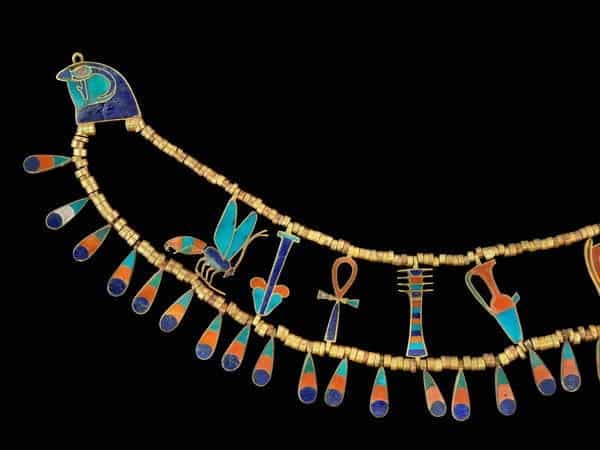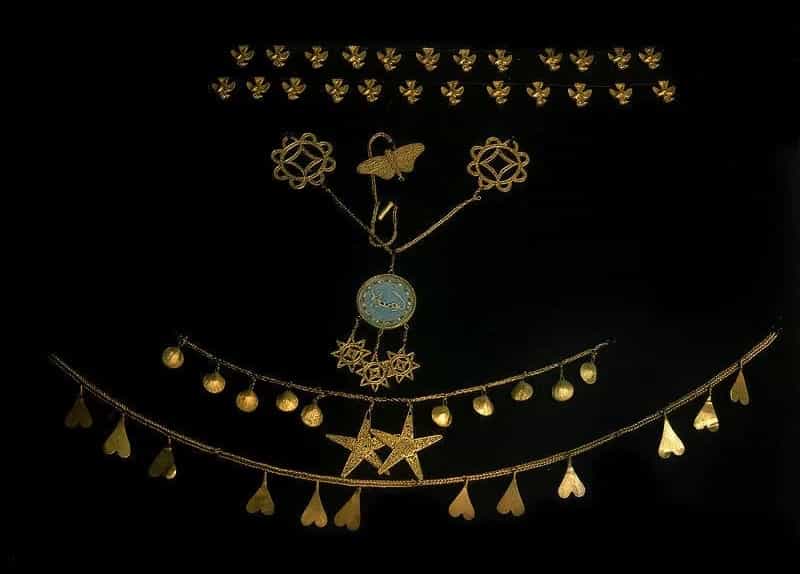In 1895, the renowned French Egyptologist Jacques de Morgan made a significant discovery in the Dashur necropolis, unearthing two intact tombs from Egypt’s Middle Kingdom. These tombs belonged to Princesses Ita and Khenmet, daughters of Pharaoh Amenemhat II, and were filled with exquisite treasures, including elaborate jewelry.
De Morgan’s archaeological career, marked by expertise and a passion for unearthing Egypt’s ancient secrets, had already secured him the role of director of the Egyptian Antiquities Service in 1892. His keen instincts and dedication led him to begin excavations in Dashur, situated roughly 10 kilometers south of Saqqara, between 1894 and 1895.
Dashur was known for housing three pyramids from the 12th Dynasty (circa 2000–1800 BC), but the surrounding cemetery, which contained many tombs, had not been thoroughly explored. This prompted De Morgan to initiate a systematic excavation, hoping to uncover the secrets buried within this ancient necropolis.
Discovery of the Royal Tombs
During his work at Dashur, De Morgan came across a heavily damaged structure that was once part of the White Pyramid of Amenemhat II. This pyramid, named for its original white limestone casing, had deteriorated significantly over the centuries, leaving only fragments of the access corridors, the subterranean chambers, and traces of the adjacent funerary temple.
Clearing away the accumulated debris proved to be a challenging task. On February 12, 1895, while working near the western wall of the pyramid, De Morgan’s team discovered a large rectangular shaft carved into the sandstone. As they removed the layers of rubble, a narrow passageway emerged, which they hoped would lead to an undiscovered burial site.
Descending the passage, they reached limestone blocks buried six meters below the surface, followed by a masonry barrier blocking further progress. Flanking this partition were two massive slabs leaning against the walls.
After removing these slabs, the archaeologists were met with an extraordinary sight: two undisturbed royal tombs. The tombs belonged to Princesses Ita and Khenmet, whose status as Amenemhat II’s daughters added immense historical value to the discovery.
A Spectacular Treasure
The two royal tombs, though situated at different depths, shared similar architectural features. Each consisted of a burial chamber containing a sandstone sarcophagus that housed a wooden coffin. Funerary texts inscribed on the coffins revealed the identities of the deceased princesses. While the mummies inside were in poor condition, various necklaces and bracelets were retrieved from the remains of the wrappings.
An adjacent chamber in each tomb contained remnants of the traditional funeral banquet, along with an assortment of grave goods. Among the artifacts found in Princess Ita’s tomb was a striking ceremonial dagger.
The weapon featured a crescent-shaped pommel and a gold-inlaid handle adorned with carnelian, lapis lazuli, and amazonite. The handle was attached to the bronze blade with three small gold pins, showcasing the exceptional craftsmanship of the period.
However, it was Princess Khenmet’s tomb that truly captivated the archaeologists with its extraordinary treasures. Within her sarcophagus, which matched Ita’s in style and dimensions, lay a wooden coffin in similarly deteriorated condition.
The mummy inside was covered in bitumen and plaster, yet surrounded by stunning pieces of jewelry. The first item to catch De Morgan’s eye was a golden funerary mask, featuring intricate blue and gold patterns and silver-inlaid eyes. Like Princess Ita, Khenmet’s head rested on a headrest, following royal burial customs.
Among the other remarkable discoveries were two garlands fashioned from gold to resemble flower wreaths. These were exquisitely decorated with materials such as glass paste, carnelian, turquoise, and lapis lazuli.
Additionally, Khenmet’s mummy was adorned with a broad necklace composed of hieroglyphic symbols crafted from gold, carnelian, lapis lazuli, turquoise, and glass paste. The ends of the necklace featured falcon heads, symbolizing the protective power of the god Horus and the pharaoh.
Message on a Bracelet
Particularly remarkable among the treasures were three gold bead bracelets, each featuring intricate clasps. These clasps weren’t merely decorative; they were inscribed with hieroglyphic symbols that conveyed a message of protection and blessing. One of the bracelets bore the phrase “All protection and life!”—a wish for well-being and vitality.
The funerary offerings, stored in an annex beside the main burial chamber, were abundant and diverse. They included remnants of food, ceramic vessels, a sealed chest containing small perfume bottles, a bronze incense burner, and a large chest holding canopic jars, which contained the embalmed internal organs of the princess. This chest occupied a significant portion of the rear section of the room.
Amid clearing away the artifacts, Jacques de Morgan experienced an unexpected find. After moving several vases aside, he uncovered a perfume box resting on a pile of luxurious items—necklaces, crowns, gold bracelets, and other jewelry, all scattered in a disorganized heap amid the debris.
This discovery at Dashur revealed the exquisite craftsmanship and artistry achieved by Egyptian goldsmiths during the late Middle Kingdom, offering a glimpse into the lavish burial practices and cultural richness of that era.
Source: Irene Cordón, National Geographic












